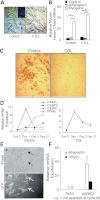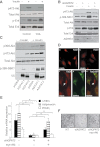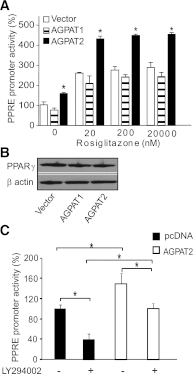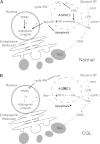Alterations in lipid signaling underlie lipodystrophy secondary to AGPAT2 mutations
- PMID: 22872237
- PMCID: PMC3478532
- DOI: 10.2337/db12-0004
Alterations in lipid signaling underlie lipodystrophy secondary to AGPAT2 mutations
Erratum in
- Diabetes. 2013 Mar;62(3):998. Elliot, Brandon [corrected to Elliott, Brandon G]
Abstract
Congenital generalized lipodystrophy (CGL), secondary to AGPAT2 mutation is characterized by the absence of adipocytes and development of severe insulin resistance. In the current study, we investigated the adipogenic defect associated with AGPAT2 mutations. Adipogenesis was studied in muscle-derived multipotent cells (MDMCs) isolated from vastus lateralis biopsies obtained from controls and subjects harboring AGPAT2 mutations and in 3T3-L1 preadipocytes after knockdown or overexpression of AGPAT2. We demonstrate an adipogenic defect using MDMCs from control and CGL human subjects with mutated AGPAT2. This defect was rescued in CGL MDMCs with a retrovirus expressing AGPAT2. Both CGL-derived MDMCs and 3T3-L1 cells with knockdown of AGPAT2 demonstrated an increase in cell death after induction of adipogenesis. Lack of AGPAT2 activity reduces Akt activation, and overexpression of constitutively active Akt can partially restore lipogenesis. AGPAT2 modulated the levels of phosphatidic acid, lysophosphatidic acid, phosphatidylinositol species, as well as the peroxisome proliferator-activated receptor γ (PPARγ) inhibitor cyclic phosphatidic acid. The PPARγ agonist pioglitazone partially rescued the adipogenic defect in CGL cells. We conclude that AGPAT2 regulates adipogenesis through the modulation of the lipome, altering normal activation of phosphatidylinositol 3-kinase (PI3K)/Akt and PPARγ pathways in the early stages of adipogenesis.
Figures








Similar articles
-
Oligomers of the lipodystrophy protein seipin may co-ordinate GPAT3 and AGPAT2 enzymes to facilitate adipocyte differentiation.Sci Rep. 2020 Feb 24;10(1):3259. doi: 10.1038/s41598-020-59982-5. Sci Rep. 2020. PMID: 32094408 Free PMC article.
-
Lipodystrophies: disorders of adipose tissue biology.Biochim Biophys Acta. 2009 Jun;1791(6):507-13. doi: 10.1016/j.bbalip.2008.12.014. Epub 2009 Jan 7. Biochim Biophys Acta. 2009. PMID: 19162222 Free PMC article. Review.
-
The human lipodystrophy gene product Berardinelli-Seip congenital lipodystrophy 2/seipin plays a key role in adipocyte differentiation.Endocrinology. 2009 Oct;150(10):4552-61. doi: 10.1210/en.2009-0236. Epub 2009 Jul 2. Endocrinology. 2009. PMID: 19574402 Free PMC article.
-
A regulatory role for 1-acylglycerol-3-phosphate-O-acyltransferase 2 in adipocyte differentiation.J Biol Chem. 2006 Apr 21;281(16):11082-9. doi: 10.1074/jbc.M509612200. Epub 2006 Feb 22. J Biol Chem. 2006. PMID: 16495223
-
The Role of the AGPAT2 Gene in Adipose Tissue Biology and Congenital Generalized Lipodystrophy Pathophysiology.Int J Mol Sci. 2025 Jun 5;26(11):5416. doi: 10.3390/ijms26115416. Int J Mol Sci. 2025. PMID: 40508223 Free PMC article. Review.
Cited by
-
What lipodystrophies teach us about the metabolic syndrome.J Clin Invest. 2019 Aug 5;129(10):4009-4021. doi: 10.1172/JCI129190. eCollection 2019 Aug 5. J Clin Invest. 2019. PMID: 31380809 Free PMC article. Review.
-
Oligomers of the lipodystrophy protein seipin may co-ordinate GPAT3 and AGPAT2 enzymes to facilitate adipocyte differentiation.Sci Rep. 2020 Feb 24;10(1):3259. doi: 10.1038/s41598-020-59982-5. Sci Rep. 2020. PMID: 32094408 Free PMC article.
-
Screening and functional validation of lipid metabolism-related lncRNA-46546 based on the transcriptome analysis of early embryonic muscle tissue in chicken.Anim Biosci. 2023 Feb;36(2):175-190. doi: 10.5713/ab.21.0440. Epub 2022 Jan 21. Anim Biosci. 2023. PMID: 35073667 Free PMC article.
-
The collaborative work of droplet assembly.Biochim Biophys Acta Mol Cell Biol Lipids. 2017 Oct;1862(10 Pt B):1205-1211. doi: 10.1016/j.bbalip.2017.07.003. Epub 2017 Jul 12. Biochim Biophys Acta Mol Cell Biol Lipids. 2017. PMID: 28711458 Free PMC article. Review.
-
AGPAT3 deficiency impairs adipocyte differentiation and leads to a lean phenotype in mice.Am J Physiol Endocrinol Metab. 2024 Jul 1;327(1):E69-E80. doi: 10.1152/ajpendo.00012.2024. Epub 2024 May 8. Am J Physiol Endocrinol Metab. 2024. PMID: 38717361 Free PMC article.
References
-
- Huang-Doran I, Sleigh A, Rochford JJ, O’Rahilly S, Savage DB. Lipodystrophy: metabolic insights from a rare disorder. J Endocrinol 2010;207:245–255 - PubMed
-
- Agarwal AK, Arioglu E, De Almeida S, et al. AGPAT2 is mutated in congenital generalized lipodystrophy linked to chromosome 9q34. Nat Genet 2002;31:21–23 - PubMed
-
- Miranda DM, Wajchenberg BL, Calsolari MR, et al. Novel mutations of the BSCL2 and AGPAT2 genes in 10 families with Berardinelli-Seip congenital generalized lipodystrophy syndrome. Clin Endocrinol (Oxf) 2009;71:512–517 - PubMed
-
- Leung DW. The structure and functions of human lysophosphatidic acid acyltransferases. Front Biosci 2001;6:D944–D953 - PubMed
Publication types
MeSH terms
Substances
Grants and funding
LinkOut - more resources
Full Text Sources
Molecular Biology Databases

